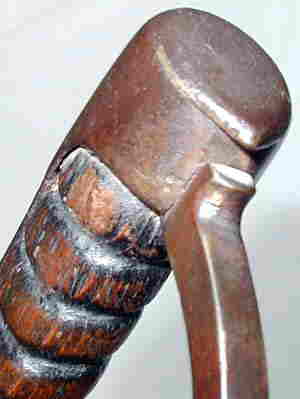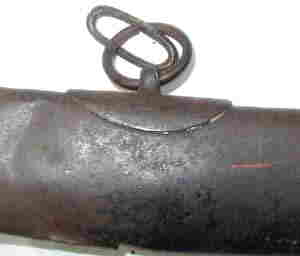|
Richard F. Burton's "The Book of the Sword" has been utilized for
the following remarks that precede this week's Collector's Item
of The Week.
With the possible exception of rocks, both blunt and sharpened,
and the first spears, the Sword is among the oldest weapon of
man. It is certainly the oldest weapon of civilized man. It is
the most universal and most varied of weapons. It has lived through
all civilized time. The "Sword of God " is frequently referred
to in biblical references and in the bible itself. It has been
consecrated to the gods and demi-gods. It has been stored in the
Temple and the Church. It has been said "If there were no Sword,
there would be no law of "Mohammed." The Moslem highest title
was "Sayf Ullah - Sword of Allah." It has been regarded as a living
thing, endowed with human and superhuman qualities. It was uniformly
a personal item.
|
|
|
|
|
|
THE "ARME BLANCHE"?
|
|
|
|
|

Grip - Obverse
|

Grip - Reverse
|
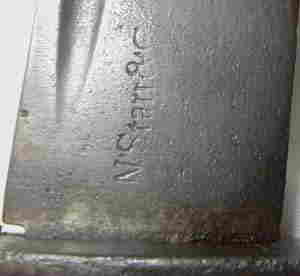
"N Starr & Co" Obverse of Blade |
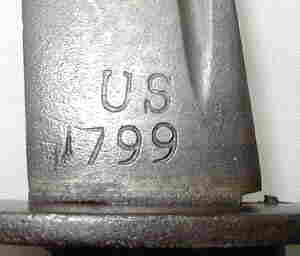
"US 1799" Reverse of Blade |
|
Blade Point |
|
|
Top of Hilt View
|
|
| Starr's cavalry saber of 1798 was the first official U.S. Sword as it was the first sword made under contract to the United States government after the Revolution. The contract was for only 2,000 swords. The curved, single edged blade has a false edge that extends 7" back from the point. It has a deep, narrow fuller at the back top of the blade that starts 3/4" from the hilt and runs to the start of the false edge. The marking of "N Starr & Co" is stamped lengthwise on the obverse side of the blade. A "US" over "1799" is stamped in 2 perpendicular lines on the reverse. It has a flat iron pommel and a stirrup shape iron knuckle bow ("D" guard). The wood grip was originally leather wrapped with twisted brass wire. | |
|
The overall length of the sword is 39¼". The hilt is 6" long.
The blade is 33¼". The thickness of the blade, at the hilt,
is ¼" and it is 1-7/16" wide at the base of the hilt.
|
|
|
|
|
|
|
|

|
|
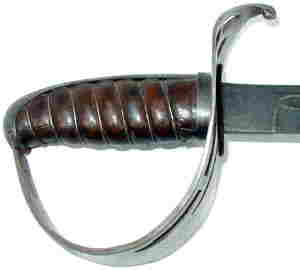
Grip - Obverse
|

Grip - Reverse
|

Bottom of Hilt View |

Top of Hilt View |
|
Blade Point
|
|
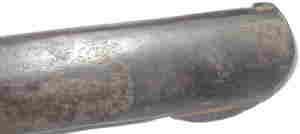
Scabbard Drag |
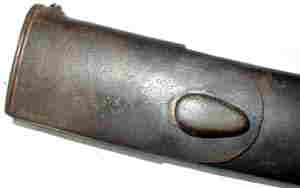
Scabbard Top |
|
Virginia Manufactory Sword With Scabbard
|
|
| The Virginia Manufactory or the State Armory was authorized in 1798. However, it did not start operation until 1802. It manufactured basically 2 types of swords. The first type had a square nut to secure the tang on top of a flat pommel formed from an expanded backstrap. The second type, pictured here, differs from the first in that the fuller shaped grips are set at a greater angle to the blade and the pommel is smooth in a bird heads pattern without the square nut. | |
| The single edge blade is sharply curved with a rudimentary false edge. There are two fullers, one wide and one narrow, just under the top of the blade. Both start at the ricasso with the wide fuller ending 8" from the point. The narrow fuller is ½" shorter. The wood grips are covered with a deep brown leather and are wound with a single heavy gauge wire (may have been rewrapped a long time ago). The knuckle bow is cut from a single piece of iron and bends evenly below the blade. It is pierced with a series of seven elongated, generally rectangular slots as it turns up and crosses the blade. It is also pierced for a sword knot near the pommel. All metal parts are iron. There are no markings anywhere on the sword or scabbard. The iron scabbard is fitted with a elongated stud for attaching to a frog. There is a rudimentary drag. The overall length of this radically curved sword is 44¼" with the blade measuring 39¼" in a straight measurement and the hilt length being 5". The thickness of the blade, at the hilt, is 5/16" and it is 1-3/8" wide at the base of the hilt. | |
|
It is hard to believe that this sword was carried on the user as
it would make for dangerous and difficult walking or running. The
scabbard, in some manner, may have been attached to the horse itself.
Many of these swords were later modified and shortened for use in
the Civil War.
|
|
|
|
|
|
|
|
|
|
|

Grip - Obverse
|

Grip - Reverse
|
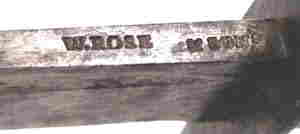
"W.
ROSE & SONS" |
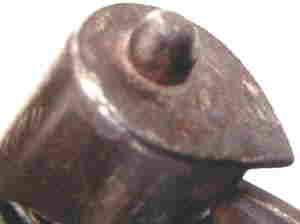
Hilt Top View |
|
Blade Point
|
|
| This William Rose & Sons cavalry saber is similar to the Rose government contract of 1807. It is not known, at this time, exactly when this sword was made or for what State troop unit. Rose made a lot of swords for different States as well as for the federal government. Until I purchased this sword last year I had never seen one exactly like it. | |
|
It has a radically curved polished ebony wood grip with twisted
brass wire. The grip is shaped somewhat like a sea horse. The iron
stirrup shaped hand guard terminates in the flat pommel which is
formed at the top of the convex iron back strap. There is a pronounced
capstan type rivet on the pommel top. The single edged curved sword
blade does not have a ricasso. A single broad fuller, just below
the back of the blade, starts ¼" from the cross guard and
extends to within 9½" of the extended clip pointed blade.
The overall length of this sword is 40¼". The blade makes
up 34¼" of that length with the hilt extending the overall
length 5½" to the tip of the capstan rivet. The blade is
3/8" thick and 1½" wide at the hilt. The only markings are
"W. ROSE & SONS" on the top of the blade at the hilt. "&
SONS" is separated substantially from the "W . ROSE" indicating
that two separate stamps were utilized for the markings.
|
|
|
|
|
|
Made by Abraham Nippes |
|

|
|
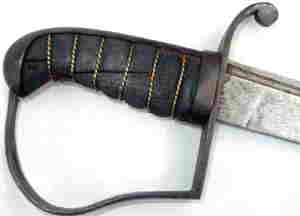
Grip - Obverse
|
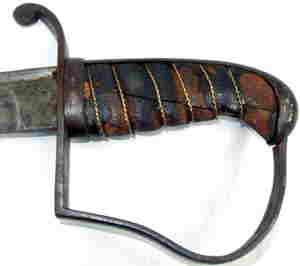
Grip - Reverse
|
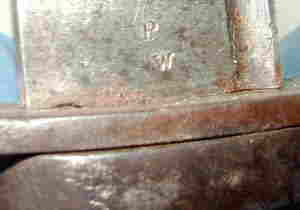
"P,
W" Marking |

Top of Hilt View |
|
Blade Point
|
|

Scabbard Drag |

Scabbard Top |
|
Middle Carrying Ring
|
|
| This sword has been identified as a Nippes manufactured 1810 contract US cavalry saber. It has been proofed by Martine T. Wickham with a "P" over a "W" on the reverse just above the hilt. In 1811 Nippes agreed to finish James Winter's 1810 contract for 500 cavalry sabers. Nippes made 478 sabers and 500 scabbards. The scabbards had 2 rings attached to plates brazed on the mouth piece and center band as pictured here. | |
| The curve angle of this single edge blade is second only to the curve of the 1802-03 Virginia Manufactory sword blade. This blade has a rudimentary false edge and a single fuller, medium in width with a deep groove starting at the base of the hilt and extending to within 9¼" of the point. The rather crude wood grips were originally covered with leather. Remnants of this leather remain as does the twisted copper wiring. The reverse "P" guard knuckle bow terminates into a smooth bird's head style pommel at the top of the metal back strap. All metal parts are iron. The knuckle bow is pierced for a sword knot. The scabbard has only a rudimentary drag. The overall length of this markedly curved sword is 39" with the blade measuring 33¾" in a straight measurement and the hilt length being 5¼". The blade, at the hilt, is ¼" thick and 1½" wide. | |
|
Descriptions were assisted by those of Harold L. Peterson's from
his basic bible for the sword collector - "THE AMERICAN SWORD, 1775-1945"
This man has cost me many thousands of dollars - May God bless and
keep him. Richard H, Bezdek's book - "SWORDS And SWORD MAKERS Of
The WAR OF 1812" was also used for reference in preparing this week's
Collector Item of the Week.
|
|
|
|
|
|
Dave Radcliffe - Swordman
|
|


